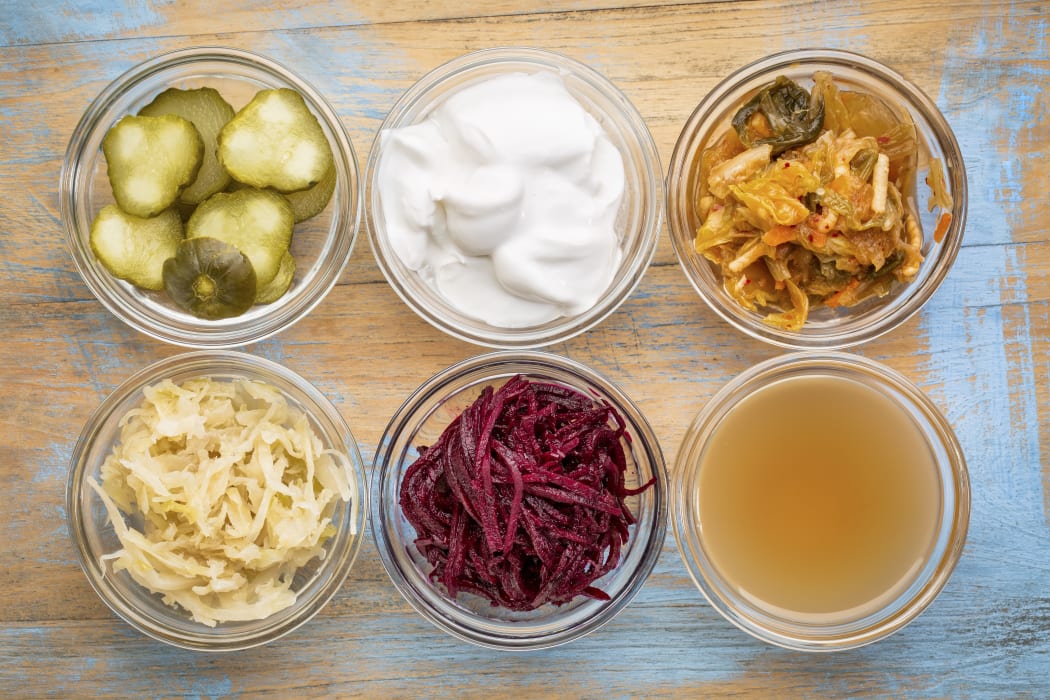Fermented foods have been recommended to keep our gut healthy so Jesse Mulligan talked to an expert on how exactly you ferment food.
Patricio Marshall is the owner of All Things Fermented, selling the components needed to make fermented food.

Photo: 123rf.com/Marek Uliasz
So, what exactly is fermentation?
Fermentation is really when yeast or bacteria consumes sugar and carbohydrates or fermentable sugars and converts it into something else, he says.
It is a process used to make foods like kombucha, kvass or kefir and they all require a SCOBY (symbiotic culture of bacteria and yeast).
“It is a culture that contains a number of different yeasts, a number of different bacteria, usually lactic bacteria but also an acetic bacteria. So, they create different types of acids. And they live sort of harmoniously together.
“And some of those bacteria can create cellulose which is why you start to see this gelatinous disk form on the top of your kombucha when it's fermenting.”
It’s worth buying a SCOBY commercially if you’re contemplating getting into fermentation, he says.
“If you're going to make something like kombucha do get a proper SCOBY rather than trying to just let wild fermentation occur. SCOBYs used to make kombucha contain the right mixture of yeast and bacteria that will give you a reliable outcome, a reliable product.”
Kombucha needs a particular temperature range, he says.
“If you can keep the temperature somewhere around 20 to 30, that's gonna favour the action or the activity of all those different yeasts and bacteria within the SCOBY to give you a good kombucha.
“But also comes down to time. Usually somewhere between seven to 10 days, you should have a nice product at that point. If you keep it going longer and longer, it's likely to get more and more acidic and more tart.”
The reason the tartness increases is because the Ph is dropping, he says, and anything below 3 is not something you should drink.
Kombucha should be seen a tonic more than a soda-type drink, he says.
“It's not something you should be drinking lots and lots of.”
When you’re making it at home, the kombucha will need oxygen to ferment properly, he says. Some muslin over the top of the jar it is in is ideal, he says.
“Allow oxygen to get in the tub for the bacteria to do its work.
“Once it's got to the point that you're quite happy with it, it's really a matter of transferring it into something that you can seal up and store cold, which can slow down the action pretty quickly.”
Once there's no access to oxygen, the bacteria can't do their job anymore so they won't make any more sourness, he says.
If you want a bit more fizz in the kombucha, add sugar when you cap it, he says.
“If you put a bit more sugar into the bottle, when you when you cap it, you will get more carbonation. So you'll need to keep it warm for maybe a week or so for the yeast to consume that sugar.”
Bottling is a key part of the process, he says.
“You want to make sure that your bottles are clean and sterile.”
Kefir is similar to kombucha, he says.
“There are two different types of kefir. You can get kefir culture that's primarily for milk or you can get a water kefir.”
The process is a bit quicker than kombucha, he says.
“It can be a bit quicker, it does also come down to the amount of sugars that you've got … milk for instance, there's not a huge amount of sugar for the bacteria to work on, so it can quite quickly convert them to acids and more or less 12 to 24 hours later, you have what resembles more like a runny yoghurt.”
Kvass is sometimes called bread beer, he told Jesse Mulligan.
“Kvass is rye bread soaked in water that has been fermented and I suppose if we go back to when it originally would have been made, it would have been a wild ferment, it would have been whatever yeast and bacteria was on the bread and whatever else was put in there that would have created a fermentation and given you a sort of tangy, slightly fizzy sort of a drink.”
Ginger-based ferments are quite easy to make at home, he says.
“Traditional ginger beer which used to be called the ginger bug, you can essentially create that pretty easily - grate up some ginger, just a little knob of ginger into a bowl with some water and some sugar and you're essentially letting the yeast and bacteria on the ginger start a fermentation.
“Keep on doing that until you see fizz and add a teaspoon or two of sugar every day until you see the fizz in the water so the carbonation is there, and you have a starter bug that you can then use to make ginger beer.”
He says fermentation is an easy bug to catch.
“It's great fun, making all sorts of different fermented beverages or foods as the case may be, it will be a bit hot and miss from time to time and takes a little while to get used to how things behave.
“I think that the big thing with any of these things, particularly if you wanted to get a consistent result, is you do have to be as clean and as sanitary as you can to ensure that the fermentation that is occurring is only occurring with the yeast and bacteria that you want to be doing the job.”

